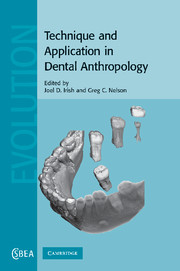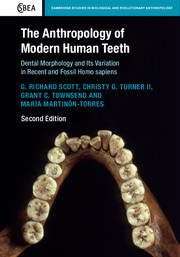Human Tooth Crown and Root Morphology
The Arizona State University Dental Anthropology System
- Authors:
- G. Richard Scott, University of Nevada, Reno
- Joel D. Irish, Liverpool John Moores University
- Date Published: March 2017
- availability: Temporarily unavailable - available from TBC
- format: Paperback
- isbn: 9781107480735
$
62.99
Paperback
Other available formats:
eBook
Looking for an inspection copy?
This title is not currently available for inspection. However, if you are interested in the title for your course we can consider offering an inspection copy. To register your interest please contact [email protected] providing details of the course you are teaching.
-
This guide to scoring crown and root traits in human dentitions substantially builds on a seminal 1991 work by Turner, Nichol, and Scott. It provides detailed descriptions and multiple illustrations of each crown and root trait to help guide researchers to make consistent observations on trait expression, greatly reducing observer error. The book also reflects exciting new developments driven by technology that have significant ramifications for dental anthropology, particularly the recent development of a web-based application that computes the probability that an individual belongs to a particular genogeographic grouping based on combinations of crown and root traits; as such, the utility of these variables is expanded to forensic anthropology. This book is ideal for researchers and graduate students in the fields of dental, physical, and forensic anthropology and will serve as a methodological guide for many years to come.
Read more- Provides detailed descriptions and illustrations of forty-two dental and oral traits with illustrations of the associated standard plaques
- A supplementary web-based application, rASUDAS, can be used to evaluate the ancestry of an individual in a forensic context
- The appendix provides full class frequency distributions for sixty populations from around the world, helping researchers put their samples into a broader geographical context
Customer reviews
Not yet reviewed
Be the first to review
Review was not posted due to profanity
×Product details
- Date Published: March 2017
- format: Paperback
- isbn: 9781107480735
- length: 342 pages
- dimensions: 248 x 192 x 25 mm
- weight: 0.7kg
- contains: 224 b/w illus. 55 tables
- availability: Temporarily unavailable - available from TBC
Table of Contents
Acknowledgments
Part I. Introduction, Background and Terminology: Introduction
Why a guidebook?
Terminology
Part II. Crown and Root Trait Descriptions:
1. Winging
2. Labial convexity
3. Palatine torus
4. Shoveling
5. Double shoveling
6. Interruption grooves
7. Tuberculum dentale
8. Bushman canine
9. Canine distal accessory ridge
10. Upper premolar accessory ridges
11. Upper premolar mesial and distal accessory cusps
12. Uto-Aztecan premolar
13. Metacone
14. Hypocone
15. Bifurcated hypocone
16. Cusp 5
17. Marginal ridge tubercles
18. Carabelli's trait
19. Parastyle
20. Enamel extensions
21. Upper premolar root number
22. Upper second molar root number
23. Lateral incisor variants
24. Pegged-reduced-missing third molars
25. Premolar odontomes
26. Midline diastema
27. Lower premolar cusp number
28. Anterior fovea
29. Mandibular torus
30. Lower molar groove pattern
31. Rocker jaw
32. Lower molar cusp number
33. Deflecting wrinkle
34. Distal trigonid and mid-trigonid crests
35. Protostylid
36. Cusp 6
37. Cusp 7
38. Lower first premolar root number (Tomes' root)
39. Lower canine root number
40. Three-rooted lower molars
41. Lower molar root number
42. Torsomolar angle
Part III. Conclusions: General considerations
Introduction
Basic concerns
Final cautionary notes
Appendix (full class frequency distributions for 29 key traits in 60 world samples)
A.1 Key to tables
A.2 Sample provenance
A.3 Samples by geographic area.
Sorry, this resource is locked
Please register or sign in to request access. If you are having problems accessing these resources please email [email protected]
Register Sign in» Proceed
You are now leaving the Cambridge University Press website. Your eBook purchase and download will be completed by our partner www.ebooks.com. Please see the permission section of the www.ebooks.com catalogue page for details of the print & copy limits on our eBooks.
Continue ×Are you sure you want to delete your account?
This cannot be undone.
Thank you for your feedback which will help us improve our service.
If you requested a response, we will make sure to get back to you shortly.
×






